
As everyone knows, the French Revolution began on July 14, 1789, when a mob of anti-royalist insurgents, high on a sugar rush from eating too much cake, attacked a government building in an event that is now invariably described as “the storming of the Bastille.” And, as almost everyone knows, the Bastille was a prison that stood on a site in eastern Paris now called Place de la Bastille.
Given its name, one might be tempted to conclude that the “Place de la Bastille” was, well, the place of the Bastille, but this is not entirely accurate. The actual building stood to the west of the present-day square, straddling what is now Rue Saint Antoine, between Boulevard Henri IV and a small street called, perhaps not coincidentally, Rue de la Bastille.
The Bastille was built starting in 1357 as a fort to protect the eastern city gate during a conflict between France and England that had begun 20 years earlier and was called, in a stroke of remarkable prescience, the Hundred Years War.
The man responsible for overseeing most of the work was one Hugues Aubriot, who later had the distinction of becoming the first person to be imprisoned in the Bastille, ostensibly for charges that included heresy, libertinage and sodomy, but actually because he had pissed off the authorities by trying to protect the city’s Jewish population. Apparently it was common practice in those days to incarcerate people for crimes that they didn’t even get to enjoy.
In any case, this set a precedent, and starting in the 15th century, the Bastille served double duty as royal castle and state prison.
Over the years, a great many illustrious convicts were held in the Bastille, most, like Aubriot, for what was known in legal circles as offe-pissement des autorités. They included Nicolas Fouquet, the finance minister who ticked off Louis XIV by becoming too wealthy and powerful, the famous yet anonymous Man in the Iron Mask, who hacked off Louis XV by originating professional wrestling, and, just before the Revolution, Voltaire, who honked off Louis XVI by, no kidding, writing a satirical poem. Those Louis were a touchy bunch.
As a prison, the Bastille was not such a terrible place. [Fact alert: parentheses aside, this paragraph is true.] Prisoners had private rooms with fireplaces, furniture and curtains (coffee machines and towel warmers were scheduled to be added in 1790). They wore their own clothes, could receive newspapers and mail, ate well and were given good medical care. Most were held for only a few months, and many, including Voltaire, were granted a pension upon release to ensure future good behavior.
In fact, conditions were so good that when a provincial minstrel and lute player named Jeanny Espèces came to the Bastille to sing his hit ballade “Follesomme Bastille Bleues” he was booed off the stage.
Not only was it fairly luxurious even by modern-day detention standards, it was far from overcrowded. By the summer of 1789, there were only eight prisoners in the whole building, including the Marquis de Sade, who had been jailed ostensibly for pissing off the authorities but actually for the crimes of heresy, libertinage, sodomy and not telegraphing his mom on Mother’s Day.
Despite its relatively lenient penal policies, the Bastille had become a symbol of royal oppression and, more importantly to the revolutionaries, was known to contain a reserve of gunpowder that they wanted to get their hands on in order to make fireworks for Bastille Day.
Sade, who sided with the anti-royalists, ostensibly because he sympathized with the plight of the commoners but actually because the king had threatened to put him in an iron codpiece, fueled the fervor by haranguing the public from his cell window, for which reason he was transferred to another correctional facility in early July.
Tensions finally boiled over on the 14th, resulting in a battle that claimed the lives of about 100 attackers, the prison governor and a few of the guards. The gunpowder was seized, and the seven remaining prisoners were freed. Two were insane and quickly reinterned elsewhere, four were forgers who soon found work with the Ministry of Justice under the Reign of Terror, and the seventh was a former government official who had been imprisoned for never getting pissed off.
Demolition of the fortress began almost immediately, and by November it was essentially leveled. The revolutionary wrecking crew obviously did a nice, thorough job, because there is hardly a trace of the Bastille left today.
Like a drive-by victim, the prison is outlined in the pavement on Rue Saint Antoine:
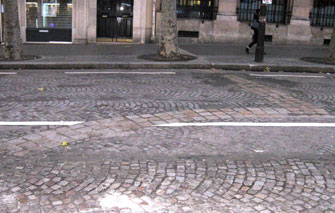
And on the Line 5 northbound platform in the Bastille Métro station:
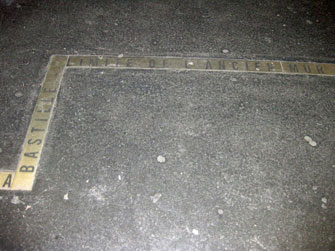
But not many actual bits of the building are still visible. You can see a fragment of the foundation in the Métro:
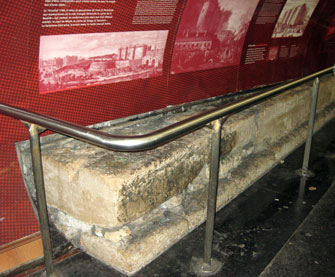
And there’s a chunk of one of the eight towers that was unearthed in 1899 and moved to Square Henri Galli, a few hundred meters away:
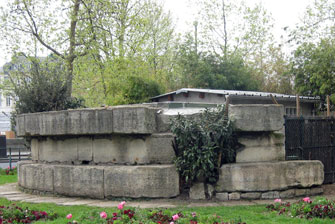
Some of the stones were carted halfway across town and used to construct the superstructure of the Pont de la Concorde:
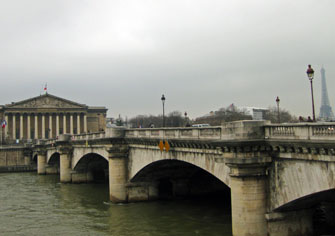
But not all. Maybe. I say this because there’s a building on Place de la Bastille that has a dent in it that looks for all the monde like a cannonball impact, framed by an inscription saying, “Souvenir 14 Juillet 1789”:
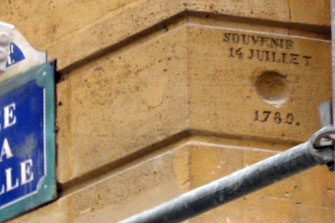
So it’s a “souvenir” of the fighting at the Bastille on that historic day. However, there’s a little problem here. Four or five stones away on the same building is another inscription identifying its date of completion as May 26, 1871:
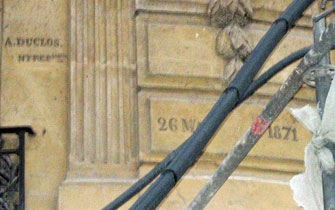
Anyone need more time to do the math? I didn’t think so.
There are two possible explanations: either the ruptured rock was recovered from the prison or a nearby building and incorporated into this one the better part of a century later, or it’s a really expensive, labor-intensive and frankly not very funny joke. Given the fact that the “souvenir” stone is of exactly the same size, color, texture and shape as all the others around it, I kiiiiiiiind of lean toward the latter.
Luckily for me, there’s an ironic twist to the history of the Bastille: it was already slated for destruction before the storming. In June 1789, the Académie Royale d’Architecture had seconded a proposal first made in 1784 to tear down the building and transform the site into an open public area with a tall column in the middle.
Hah! Fat chance! It’s a good thing the Revolution derailed that harebrained plan, so that, after all the fighting, the Reign of Terror, thousands of grisly, unjust executions and a string of further violent upheavals and re-revolutions over the subsequent century, we could end up with the present-day Place de la Bastille:
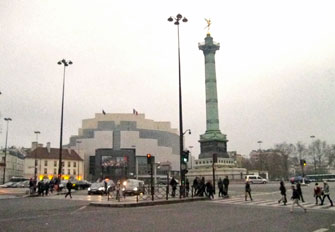
An open public area with a tall column in the middle.
Epilogue
When the aborted official plans to demolish the Bastille were revealed in the middle of the second week of September 1789, the news spawned a rumor that Louis XVI had ordered spies to plant explosives (the gunpowder) inside the so-called “Octuplet Towers,” the most prominent bastion of royal power in the country’s largest city, and then hired fake “revolutionaries” to attack it so he could blame the whole thing on terrorists as a pretense for limiting freedoms, expanding his powers and improving his public image.
However, the idea was so preposterous that no one in their right mind believed it, and ever since then the incident has been taught as part of the standard history curriculum in many universities (Yale, for instance) as an example of how pointless and ludicrous conspiracy theories can be.
Reader Carol McFarland writes: “Thank you, David Jaggard, for this humorous recreation of the history of the Bastille. I rent near there yearly and have noticed some of the souvenirs that you mention. Now I’ll chuckle a bit more as I see them and recall your histoire.”
Reader David Lebovitz writes: “I was in the Bastille once, and some tourists stopped me to ask, “Excuse me, can you tell us where the Bastille prison is?”
© 2013 Paris Update
FavoriteAn album of David Jaggard’s comic compositions is now available for streaming on Spotify and Apple Music, for purchase (whole or track by track) on iTunes and Amazon, and on every other music downloading service in the known universe, under the title “Totally Unrelated.”
Note to readers: David Jaggard’s e-book Quorum of One: Satire 1998-2011 is available from Amazon as well as iTunes, iBookstore, Nook, Reader Store, Kobo, Copia and many other distributors.
